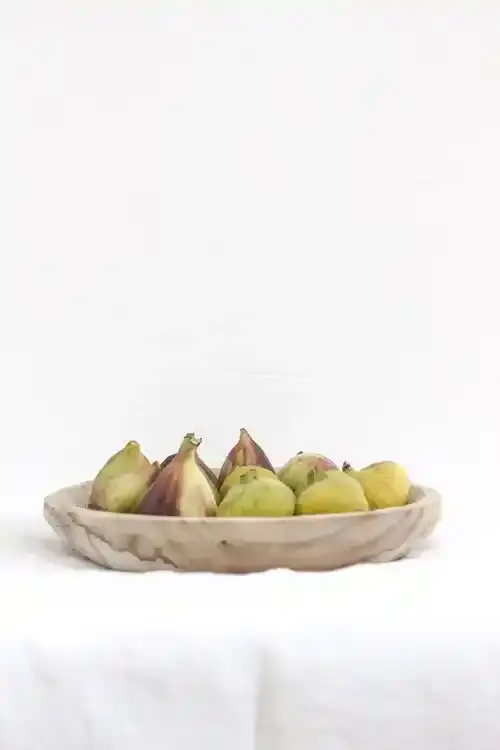Everyone should try fresh figs once on all
Although we eat it like fruit, figs are technically a flower. Or rather, a whole bouquet of flowers growing on trees! Let me explain to you. A single fig is a group of small, inverted flowers growing inside a pod called an inflorescence. Each fig contains hundreds of flowers, and each flower produces a small seed, somewhat similar to the structure of raspberries, blackberries, and strawberries. Due to where they originate, fresh figs are mostly associated with Mediterranean diets and cuisine. It now grows in California, which has a climate similar to the warm and dry Mediterranean climate.
Show key points
- Despite being eaten like fruit, figs are actually clusters of inverted flowers growing inside a pod called an inflorescence.
- Fresh figs are closely tied to Mediterranean cuisine but are also cultivated in California due to its similar climate.
- There are many varieties of figs—such as black, Adriatic, Kaduta, and Striped Tiger—each with unique colors, sweetness levels, and culinary uses.
- ADVERTISEMENT
- Whole figs are completely edible and can be enjoyed fresh, with or without slicing, and pair excellently with yogurt, oats, and cheese.
- Fresh figs have two short seasons, one starting as early as May and another from late August to November, depending on the region.
- Figs combine well with a wide range of flavors, including cheeses, nuts, herbs, bacon, and sweet elements like honey and dark chocolate.
- To extend their shelf life, fresh figs should be refrigerated unwashed, or preserved by drying or freezing once fully ripe.
The best varieties of figs for recipes

The most common and most available figs in grocery stores are dark purple black figs and light brown-green figs. However, there are actually hundreds, perhaps even thousands, of fig species! Here are the types you may find in grocery stores. They differ in color, flavor and sweetness, but they all work for the best fig recipes:
Recommend
Black, brown, purple figs

Black fig. It can be recognized by its very dark purple and almost black scales. When ripe, black figs are one of the sweetest!
Dark brown figs, sometimes spotted dark brown or spotted green, usually the largest on average
Green figs
Adriatic fig, light green skin, pale pink to almost white inside, sometimes called "white fig"
Calimerna figs. Mediterranean smyrna figs, light green from California, are often dried to concentrate their flavor
Fig Kaduta, a bright green peel on the outside, a vibrant pink on the inside, is not as sweet as other varieties, which makes it great in preparations where you can add some sweetness like bread
Fig Sierra. Native California variety, pale green peel on the outside, pale pink inside
Striped tiger figs also known as Candy Stripe or Panache. A green-yellow peel striped vertically on the outside, bright pink on the inside.
Striped tiger figs are my personal favorite because of their bright green color and visual aesthetics, but to be honest, I probably couldn't recognize any of these figs in a blind taste, except perhaps the Kaduta fig, whose vibrant pink color hides its somewhat neutral flavor from the inside. In local farmers' markets or even in your backyard, you may find special varieties. Always try it!
How to eat figs
Eat figs the same way you eat strawberries, directly. Whole figs are edible, the peel and small seeds inside, so you can eat the figs whole! You can also cut the tip of the fig, cut the figs lengthwise from the stem down into halves or quarters and enjoy it sweet and ripe as it is. Technically, the fig stem is edible but tough and offers no flavor or nutritional value, so twist or cut it. Simply chopped fresh figs are great in yogurt, oats and chia dishes and form a great decoration for cakes that do not require any frost or very sweet decorations. If you like the sticky sweet fig jam we all know as an accompaniment to cheese boards and cold cuts, you'll love fresh whole figs paired with cheese for a completely different dimension.
The best fig recipes with flavors

Figs are rich, sweet, have a unique texture and low acid. When thinking about how to cook and eat fresh figs, consider the following complementary flavors:
Cheese: Ricotta cheese, goat cheese, feta, cambodola or any other light blue cheese – feta and blue are my personal favorites!
Nuts: Almonds, Pistachios, Walnuts
Sweet: dark chocolate, honey, balsamic vinegar, rose and rose water, other types of berries
Tasty: Bacon
Herbal: Basil, Mint, Rosemary, Watercress, Radiquio
When is fig season
Fresh figs are usually considered a summer fruit because they are officially in their season from May to November. But technically, figs have two very short "seasons" at each end of summer. The first season can start as early as May, depending on the fig variety and your location. Fresh figs then disappear during the peak of the summer season and return to their second season, which begins in late August and can last until November. Figs have long been considered a late summer fruit! Early in the season, the first fresh figs aren't as sweet and tasty as they will be later in the summer, or better yet, after a few months of swelling in the summer sun. If you have fig trees or neighbors have fig trees, you know this course well. Dried figs are available all year round! And if you find yourself with a lot of fresh figs, you can dry them yourself to keep them longer, or even freeze fresh figs!
How to store, dry, freeze and preserve fresh figs
Fresh figs are rather delicate and should be treated in the same way as raspberries. Store it without washing it in its own container in the refrigerator to prevent bruising. Fresh figs remain valid for about five days in the refrigerator, but are best eaten within two days of purchase. Wash it just before eating. If you find yourself with an abundance of figs that you can't eat, cook, bake, or otherwise consume during the five- or six-day period, try drying or freezing them to store them longer.
Pro tip: Freeze fresh, highly ripe and sweet figs now, so you can use them later in the season in seasonings and sauces like the best cranberry sauce on Thanksgiving, or with cheese during holiday entertainment.








